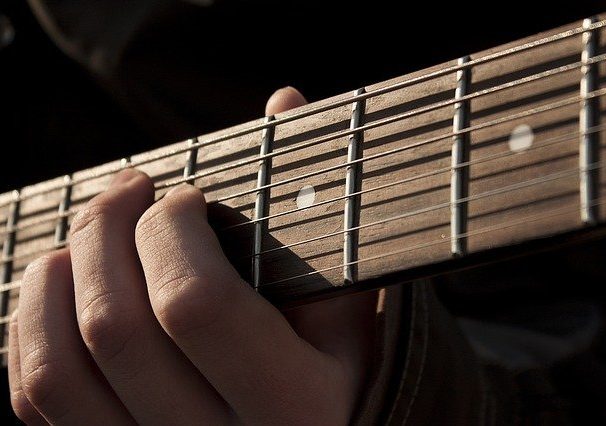
For solos and improvisation, you should make mastering the blues scale a priority. It adds an extra dimension to your solos. Let’s take a look at the blues scale and how to use it.
What is the blues scale?
The blues scale is a series of six notes pulled from any octave. There are major and minor blues scales. The major blues scale contains the 1, 2, b3, 3, 5, and 6 scale degrees. The minor blues scale contains the 1, b3, 4, b5, 5, and b7.
Knowing your major and minor pentatonic scales makes creating the blue scale a simple exercise. In both major and minor cases, the blues scale is identical to the pentatonic scale except for the addition of one note.
Need help learning the pentatonic scales?
Notice in the definition above that in the major blues scale, a flatted 3rd appears. This flatted 3rd turns the major pentatonic scale into the major blues scale.
A flatted 5th transforms the minor pentatonic scale into the minor blues scale.
The major blues scale a closer look
As I said above, in the major blues scale a flatted 3rd note is added to the major pentatonic. It doesn’t matter which box of the major pentatonic scale you start with.
For instance, in the key of A major, the pentatonic scale includes the notes A, B, C#, E and F#. The note C# is the 3rd.
So, to turn the A major pentatonic scale into the A major blues scale, add a C note. That’s the flatted 3rd.
To play the A major blues scale in the Box 1 position, press fret 5 of the Low E string with your middle finger for the root note A. With your pinky play fret 7 of the Low E for the 2nd, the B.

Next, move to the A string and reach back to fret 3 with your pointer for the C note. That’s the flatted 3rd. Slide your pointer up to fret 4 for the C#, the 3rd. Use your pinky on fret 7 for the 5th, the E.
Finally, on the D string, press fret 4 with your pointer for the 6th, the F#. Press fret 7 with your pinky to get back to the root note. The figure shows this pattern plus extends it across the rest of the strings.
Notice how similar this scale box looks to Box 1 of the major pentatonic scale. Also notice that Box 1 of the major blues scale is a bit difficult to play since the flatted 3rd note on the A string requires an extra reach. It’s much easier to add that note when it appears on the G string because you can easily use your pointer, middle, and ring fingers to play the three notes on that string.
The minor blues scale a closer look
Similarly, we can form the minor blues scale easily from the minor pentatonic scale. Again, regardless of the minor pentatonic box you’re using, just add a note–this time the flatted 5th–and you have the blues scale.
For instance, to play the blues scale in A minor, start in position to play Box 1 of the A minor pentatonic scale.
Your pointer plays the root note A at fret 5 of the Low E string. Press fret 8 for the flat third, the C note.

Next, move to the A string and play the D at fret 5 with your pointer for the 4th. Use you middle finger to play the flatted 5th, Eb, at fret 6. Your ring finger plays the 5th at fret 7 which is the E.
Finally, move to the D string and press fret 5 for the flatted 7th note G. The ring finger at fret 7 brings you back to the root. Again, the figure shows the scale extended up to the higher strings.
On the higher strings, use your pinky to reach the flatted 5th at fret 8 of the G string.
Use the same five boxes for the blues scale as for the pentatonic scale
We won’t go through all of them here, but you can find the extra note that creates the blues scale in each of the five pentatonic box shapes whether major or minor.
Therefore, you can work through each of the five positions that you know for the major blues scale and find all of the flatted 3rd notes. Similarly, you can work through the five shapes of the minor pentatonic scale to find all of the flatted 5th notes.
Again, adding this extra note to any of the pentatonic boxes creates the blues scale.
For this reason, the extra note in each scale is called the blue note.
What is the blue note?
The blue note is the note that is added to the major or minor pentatonic scale to turn the scale into a major or minor blues scale. For the major blues scale, the extra note is the flatted 3rd degree. For the minor blues scale, the extra note is the flatted 5th degree.
An interesting correlation makes learning the blues scale even easier
Now that you understand how to create the blues scale, you might feel overwhelmed by the thought of working this out for 10 different pentatonic boxes. After all, five major and five minor, so that’s a lot to remember.
But there’s good news. In every case, the flatted 3rd note of the major blues scale falls in the same place as the flatted 5th note of the minor blues scale that uses the same shape.
Confused? An example makes this much easier to understand.

From your study of the pentatonic scales, you know that Box 1 of the minor pentatonic scale uses the exact same shape as Box 5 of the major pentatonic scale.
In the A minor pentatonic scale, Box 1, the flatted 5th note appears in two places. First you find it on the A string at fret 6. Next you find it on the G string at fret 8.
Remember that this same box played in the same position is also Box 5 of the C major pentatonic scale. Notice that the same note that represents the flatted 5th of the A minor scale also represents the flatted 3rd of the C major scale.
What all this means is that you need just remember where the flatted 5th is in the five minor pentatonic shapes. Those positions are also the positions of the flatted 3rd notes in the same shapes when they’re used for the major blues scale.
How to use the blues scale as you solo
Using the blues scale as a basis for your solos adds that extra cool little dimension to your playing. But there are a few things to keep in mind as you run through your solos.
Don’t over use the blue note
Just because you now have a new note to use in your solos doesn’t mean you should always use it. Part of the beauty of the blues scale as a soloing base is that it gives you that extra tasty note.
The blue note doesn’t belong in the major or minor scale. In other words, it’s a chromatic note, not a diatonic note. Because of this, it’s a surprising sound. It sounds a bit dissonant. Like it doesn’t really belong. That’s because it doesn’t really belong.
But that’s exactly what makes it sound so cool.
However, if you over use it, it’ll lose its cool. The listener will stop being surprised by it. It’ll become trite and boring.
Treat it like salt on your french fries. It makes your licks just a bit more tasty, but over use it and you can ruin an otherwise great solo.
Don’t land on the blue note
Of course, never say “never”. There are exceptions to every rule. And all of the other old sayings. But for the vast majority of situations, you don’t want to come to rest on the blue note.
Because that note is not part of the key you’re playing in, you don’t want to give it too much importance. You don’t want to call too much attention to it.
Treat the blue note mostly as a passing note. A note that you play quickly on your way from one diatonic note to another. These types of passages can be super impactful.
As long as you hit the blue note and move off of it relatively quickly, it’ll sound great. Linger on that note and, as Ricky Ricardo used to say, “you’ll have some e’splainin’ to do.” Bonus points if you get that reference!
Experiment with how you get to the blue note
In the scale charts in this article, I’ve given you prescribed fingering. But you don’t have to access the blue note exactly in that way. It’s a good way, but not the only way. There are other ways to use it.
First, you could fret the note below the blue note and then bend the string up until you hit the blue note. Especially in the blues and rock and roll, string bends like this are super common and ultra cool.
For another cool effect, bend up to the blue note and then release the bend back to the note below it.
Next, you can slide into the blue note from any note below it. But it sounds really cool to slide up from the note directly below it so you’re sliding up one fret. And like with the bend, you could slide up to it and quickly slide back down to the note below.
Finally, try some combination of hammer ons and pull offs that incorporate the blue note. These are great techniques for sounding the note just quickly enough to catch the listener’s attention before you go on to other more expected notes.
Conclusion
Making the blues scale a basis for solos gives you another dimension that brings interest to your playing. There are both major and minor blues scales.
These scales are easily formed by adding a flatted 3rd note to a major pentatonic scale, or a flatted 5th to a minor pentatonic scale.
This relationship to the pentatonic scales makes the blues scale a simple device to learn and play. You just need to add the extra note–the blue note–to the pentatonic box shapes you already know.
But don’t over use the blue note. It sound great because it’s unexpected since it is chromatic. But if you use it too much, it’ll lose its surprise value.
There are several interesting ways you can get to the blue note during your playing. Just remember to use it as a passing tone instead of landing on it.
When used right, the blues scale adds an interesting dimension to your playing.
